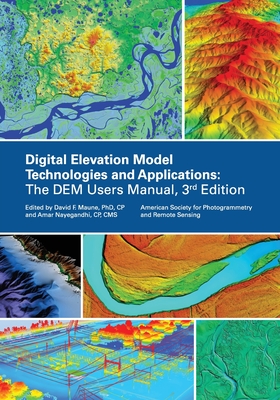Digital Elevation Model Technologies and Applications, The DEM Users Manual, 3rd Edition -

Digital Elevation Model Technologies and Applications, The DEM Users Manual, 3rd Edition -
Introduction to DEMs
Vertical Datums
Standards, Guidelines & Specifications
The National Elevation Dataset (NED)
The 3D Elevation Program (3DEP)
Photogrammetry
IFSAR
Airborne Topographic Lidar
Lidar Data Processing
Airborne Lidar Bathymetry
Sonar
Enabling Technologies
DEM User Applications
DEM User Requirements & Benefits
Quality Assessment of Elevation Data
A. Acronyms
B. Definitions
C. Sample Datasets
This book is your guide to 3-D elevation technologies, products, and applications. It will guide you through the inception and implementation of the U.S. Geological Survey's (USGS) 3D Elevation Program (3DEP) to provide not just bare earth DEMs, but a full suite of 3-D elevation products using Quality Levels (QLs) that are standardized and consistent across the U.S. and territories. The 3DEP is based on the National Enhanced Elevation Assessment (NEEA) which evaluated 602 different mission-critical requirements for and benefits from enhanced elevation data of various QLs for 34 Federal agencies, all 50 states (with local and Tribal input), and 13 non-governmental organizations. The NEEA documented the highest Return on Investment from QL2 lidar for the conterminous states, Hawaii and U.S. territories, and QL5 IFSAR for Alaska.
Chapters 1, 3, 5, 8, 9, 13, 14, and 15 are "must-read" chapters for users and providers of topographic lidar data. Chapter 8 addresses linear mode, single photon and Geiger mode lidar technologies, and Chapter 10 addresses the latest in topobathymetric lidar. The remaining chapters are either relevant to all DEM technologies or address alternative technologies including photogrammetry, IFSAR, and sonar.
As demonstrated by the figures selected for the front cover of this manual, readers will recognize the editors' vision for the future-a 3-D Nation that seamlessly merges topographic and bathymetric data from the tops of the mountains, beneath rivers and lakes, to the depths of the sea.
David F. Maune, PhD, CP
Amar Nayegandhi, CP, CMS
Co-Editors
PRP: 488.17 Lei
Acesta este Prețul Recomandat de Producător. Prețul de vânzare al produsului este afișat mai jos.
390.54Lei
390.54Lei
488.17 LeiLivrare in 2-4 saptamani
Descrierea produsului
Introduction to DEMs
Vertical Datums
Standards, Guidelines & Specifications
The National Elevation Dataset (NED)
The 3D Elevation Program (3DEP)
Photogrammetry
IFSAR
Airborne Topographic Lidar
Lidar Data Processing
Airborne Lidar Bathymetry
Sonar
Enabling Technologies
DEM User Applications
DEM User Requirements & Benefits
Quality Assessment of Elevation Data
A. Acronyms
B. Definitions
C. Sample Datasets
This book is your guide to 3-D elevation technologies, products, and applications. It will guide you through the inception and implementation of the U.S. Geological Survey's (USGS) 3D Elevation Program (3DEP) to provide not just bare earth DEMs, but a full suite of 3-D elevation products using Quality Levels (QLs) that are standardized and consistent across the U.S. and territories. The 3DEP is based on the National Enhanced Elevation Assessment (NEEA) which evaluated 602 different mission-critical requirements for and benefits from enhanced elevation data of various QLs for 34 Federal agencies, all 50 states (with local and Tribal input), and 13 non-governmental organizations. The NEEA documented the highest Return on Investment from QL2 lidar for the conterminous states, Hawaii and U.S. territories, and QL5 IFSAR for Alaska.
Chapters 1, 3, 5, 8, 9, 13, 14, and 15 are "must-read" chapters for users and providers of topographic lidar data. Chapter 8 addresses linear mode, single photon and Geiger mode lidar technologies, and Chapter 10 addresses the latest in topobathymetric lidar. The remaining chapters are either relevant to all DEM technologies or address alternative technologies including photogrammetry, IFSAR, and sonar.
As demonstrated by the figures selected for the front cover of this manual, readers will recognize the editors' vision for the future-a 3-D Nation that seamlessly merges topographic and bathymetric data from the tops of the mountains, beneath rivers and lakes, to the depths of the sea.
David F. Maune, PhD, CP
Amar Nayegandhi, CP, CMS
Co-Editors
Detaliile produsului









